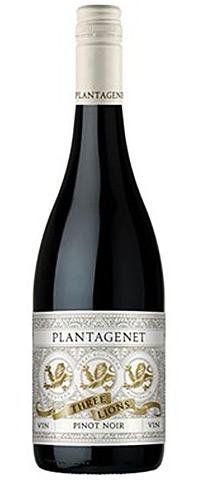
Three Lions Great Southern Pinot Noir
Three Lions Pinot Noir is deep ruby red in colour. On the nose, there are lifted aromas of red cherry, raspberries and a savoury complexity that leads into a palate bursting with bramble fruits and toasty oak. This Pinot Noir is beautifully textured with fine tannins and balanced acidity.
Plantagenet’s total 126 hectares of vineyard have been carved out of the region’s distinctive Marri soils named after the massive native Marri, or Red Gum trees that grow here. The soils are gravelly loams with good drainage over a base of clay, sand or the ironstone rock, ensuring that the vines are not over-watered or over-fertilised, thus allowing for optimal fruit concentration.
The climate is cool-temperate and strongly influenced by the proximity of the Southern Ocean. Rainfall is plentiful and even during the hottest Australian summer, daytime temperatures are moderated by cooling evening sea breezes. The warm days and cool nights of the Great Southern allow maximum retention of the varietal flavours and aromas required for complex wines.
The combination of these ancient soils and cool maritime climate offers an environment perfect for growing premium wine grapes and making wines that are expressive of the place from which they come.
To find out more about the winery go to http://www.plantagenetwines.com/
To see our full range of Plantagenet wines go to https://www.auswinesonline.co.uk/product-category/plantagenet/
The Plantagenet’s were the first truly armigerous royal dynasty of England meaning they were entitled to strike and bear various coats of arms. The arms of this noble, later royal, family, Gules, three lions passant guardant, termed colloquially “the arms of England” were first adopted by King Richard the Lionheart (1189–1199), son of King Henry II of England (1154–1189), son of Geoffrey Plantagenet, Count of Anjou (1113/17–1151).
These Three Lions signified royalty, history, power and a code of conduct that was instantly recognized wherever they were displayed.
So too with this range of wines. They are from the oldest established winery in Great Southern – they are wines with power and provenance. The Three Lion coat of arms of Plantagenet Wines is a recognized symbol of quality and prestige.
Three Lions Pinot Noir is a great Western Australian wine
£18.99 a bottle
6 in stock
“The Plantagenet wines enjoy enormous success. The purity of fruit captured by winemaker Richard Robson, allied to their reasonable prices, illustrate the reasons for this success.
While the Plantagenet wines all come from grapes grown in mature vineyards in Mt. Baker, the Omrah range is made from fruit from younger vineyards, or from bought in fruit. This range also offers excellent value, something that has made them a hit in Australia.
“
The largest region in Western Australia and has four sub-regions, Albany, Frankland River, Mount Barker and Porongurup. As with Margaret River the suitability of this region for premium quality wines was as a result of two research reports from Californian viticulturalist Professor Harold Olmo and the Western Australian scientist Dr John Gladstone in the 50s and 60s and the ongoing enthusiasm of Bill Jamison, the Western Australia’s state viticulturaist at the time. In 1965 there were experimental plantings at Forest Hill. Further trials took place and by 1972 the first harvest was sent to Houghtons and Sandalford for winemaking by Jack Mann and his son Dorham. What transpired was development that gained momentum in the 70’s and accelerated in the 80’s. The climate is maritime influenced Mediterranean, with significant differences reflected between the sub-regions. The main wine styles: Red – Shiraz, Cabernet Sauvignon, Pinot Noir; White – Riesling, and Chardonnay.
“The famous grape of Burgundy. The classic style is medium colour, with fragrant berry, violet and gamey-earthy aromas, and soft, full sweet berry flavours, with velvety tannins.
This variety is most suited to a long cool growing season that are found in southern Victoria (noteable Yarra Valley), Adelaide Hills of South Australia, and southern regions of Western Australia.”
This website uses Cookies to improve your browsing experience. View Cookies Policy
I'm fine with this